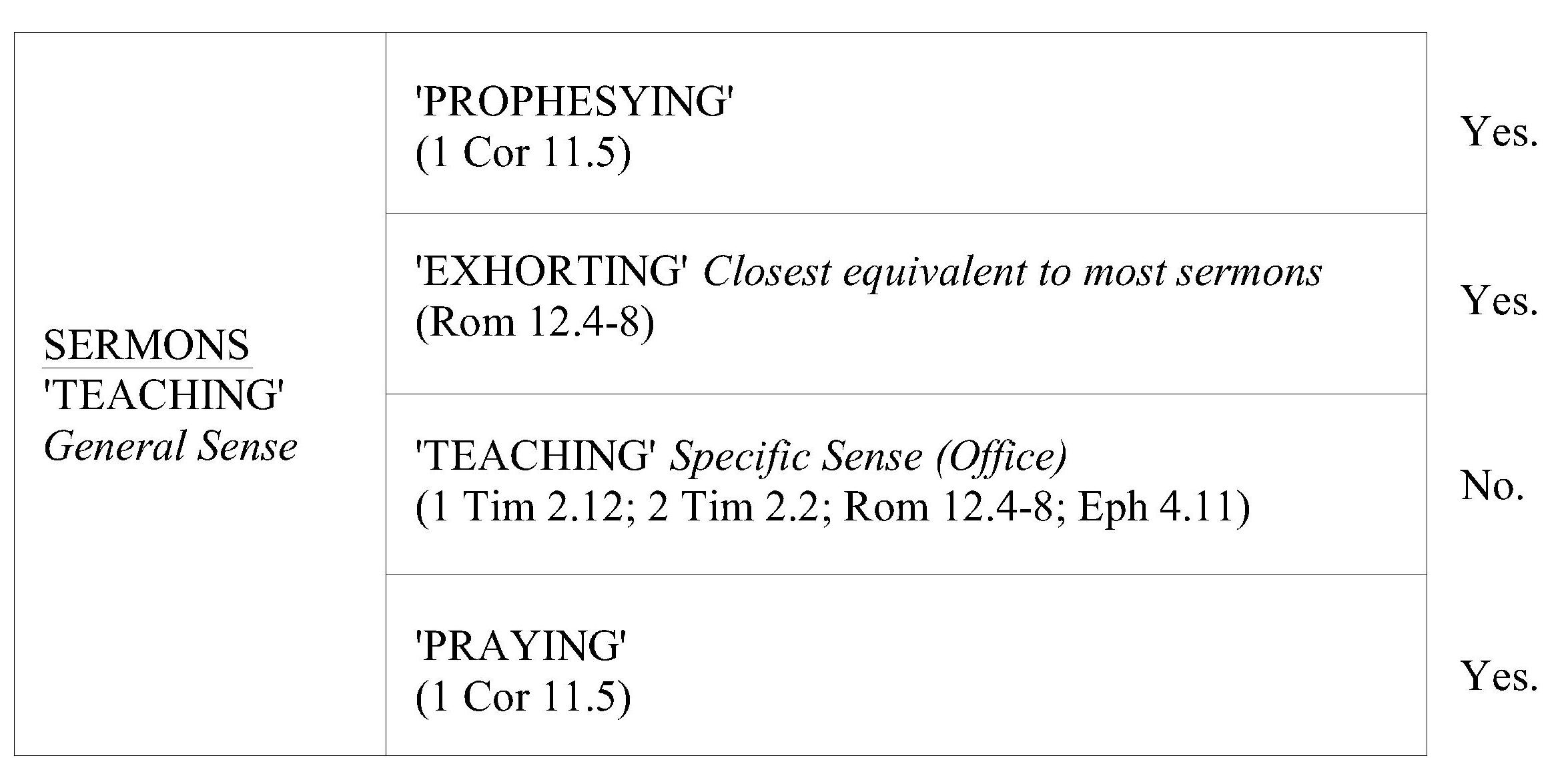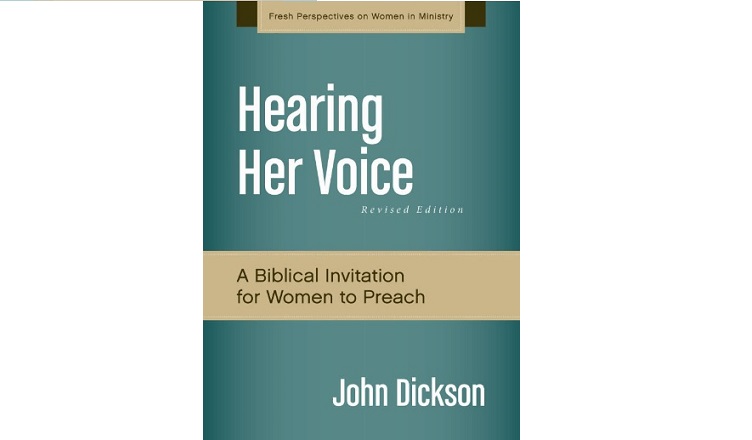The apostle Paul says, “I do not permit a woman to TEACH or to exercise authority over a man; rather, she is to remain quiet.” (1 Tim 2.12)
Dickson is in full agreement with Paul’s command that women should not ‘teach’. However as his book reveals he goes into some detail explaining that how we normally understand the verb ‘teach’ is quite different from the specific activity Paul is referring to in this controversial verse.
- Link: Amazon
- Length: 107
- Difficulty: Medium-Easy
- Topic: Topical, Women, Preaching
- Audience: Mainstream Christians
- Published: 2014
Dickson’s book does a study on the verb ‘teach’ in the New Testament. In doing so he provides a plausible argument for Paul’s meaning in this verse and subsequently builds a case for women to give specific kinds of sermons in churches.
This book review is one of three on debates surrounding women giving sermons. The other reviews are:
- Bird, Bourgeois Babes Bossy Wives and Bobby Haircuts (Link), and
- Bolt, Payne, Women Sermons and the Bible (Link).
This post is one of my book reviews.
Contents
- Introduction: A Very Modest Argument
- Part 1: Teaching Isn’t Everything: What 1 Timothy 2:11–12 Cannot Mean
- 1.1. Women Speaking in the New Testament
- 1.2. Women Speaking in the Old Testament
- 1.3. Prophesying and Teaching
- 1.4. Exhorting and Teaching
- 1.5. A Preliminary Conclusion
- Part 2: Laying It Down: What Teaching Really Is
- 2.1. General and Technical Teaching
- 2.2. The Use of Historical Background to Understand the Bible
- 2.3. Oral Tradition in Christianity
- 2.4. Oral Tradition among the Pharisees
- 2.5. The Role of the Teacher before There Was a New Testament
- Part 3: Explain and Apply: How Exposition Differs from Teaching
- 3.1. Teaching as Scriptural Exposition?
- 3.2. “Teaching” in the Pastoral Epistles and Beyond
- 3.3. Teaching That Was Written Down
- 3.4. A First-Century Church Service (A Thought-Experiment)
- Part 4: Teaching No More? How Modern Sermons and Ancient Teaching Are Connected
- 4.1. The Teaching Role of the New Testament Canon
- 4.2. What Is a Modern Exposition?
- 4.3. Missing New Testament Roles?
- Conclusion: Three (or Four) Responses
- Discussion Questions
- Endnotes
Main points
Traditional Position
The traditional position as far as I know it is that women are prohibited from teaching in church. Giving sermons is generally understood as teaching people from the scriptures. Therefore women are forbidden to teach men the scriptures.
Different kinds of speech in Church
Dickson begins by arguing that scripture makes a distinction between different kinds of speaking roles in the church. He quotes Rom 12.4-8 and 1 Cor 11.5.
4 For as in one body we have many members, and the members do not all have the same function, 5 so we, though many, are one body in Christ, and individually members one of another. 6 Having gifts that differ according to the grace given to us, let us use them: if prophecy, in proportion to our faith; 7 if service, in our serving; the one who teaches, in his teaching; 8 the one who exhorts, in his exhortation; the one who contributes, in generosity; the one who leads, with zeal; the one who does acts of mercy, with cheerfulness. (Rom 12.4-8)
‘Teaching’ is one of the gifts listed, and so is ‘prophecy’ and so is ‘exhorting’, but according to Paul these are ‘gifts that differ’ (v6). Consequently Paul means by ‘teaching’ is in some way different from ‘prophecy’ and ‘exhortation’.
4 Every man who prays or prophesies with his head covered dishonors his head, 5 but every wife who prays or prophesies with her head uncovered dishonors her head, since it is the same as if her head were shaven. (1 Cor 11.5)
In the context of this debate, everyone’s observation is that women are allowed by Paul to pray and prophesy in church.
Definition of ‘teach’ in the general sense
16 Let the word of Christ dwell in you richly, TEACHING and admonishing one another in all wisdom, singing psalms and hymns and spiritual songs, with thankfulness in your hearts to God. (Col 3.16)
To better appreciate Dickson’s argument, one must understand the he is applying different understandings of ‘teaching’ in different texts. The general and specific senses. The verse above is one example of the general sense. Dickson rightly includes women in this act of teaching. Teaching through song.
“Teaching” in the Bible can be used in a variety of ways. Its root or broad idea is the transmission of truth from the learned to the learner. But this does not mean that every instance of the term only has this broad sense, (30)
Here he defines his understanding of the general sense: The transmission of truth from the learned to the learner.
Definition of ‘teach’ in the specific sense
2 You then, my child, be strengthened by the grace that is in Christ Jesus, 2 and what you have heard from me in the presence of many witnesses entrust to faithful men, who will be able to TEACH others also. (2 Tim 2.1-2)
Dickson argues, ‘teaching’ is also a specific activity in a specific context. He begins explaining word meanings can be broad and flexible. They can be applied in different ways.
In all languages, individual terms can serve a variety of purposes. This is because words frequently have root meanings that are broad enough to allow the word to be used in different ways in different contexts. It is not that the word always has the broadest meaning; it is that terms are flexible, sometimes signifying one thing, sometimes signifying another—always related to the root idea. (29)
Then he explains Paul has a specific application for the word verb teach in the Pastoral Epistles.
“Teaching” in the Pastoral Epistles (1 and 2 Timothy and Titus), and elsewhere in Paul’s letters, usually has a technical or specific sense. It never leaves behind the abstract idea of transmitting truth, but it does focus on one specific idea: transmitting intact the new covenant words of the apostles. (30)
Here he defines the application of teach in the Pastoral Epistles with this specific sense: The transmission of the new covenant words of the apostles.
The specific role of the ‘teacher’
11 And he gave the apostles, the prophets, the evangelists, the shepherds and TEACHERS, 12 to equip the saints for the work of ministry, for building up the body of Christ. (Eph 4.11)
From what I know of the historical context of the early church, written documents were quite rare and expensive to create. Subsequently memorisation of texts was highly important and necessary for transmission of knowledge when the text was unavailable.
Dickson goes into a little detail (little, like the visible bit of an iceberg) explaining the role of the teacher in the early church times. He explains the Pharisees had ‘teachers’ who were responsible for memorising and telling others of the traditions of the elders. When Christianity came about they adopted similar roles and practices to keep their body of knowledge. The oral teachings about Jesus that eventually took the form of the Gospels – Matthew, Mark, Luke and John.
In short, Jesus “handed down” his own authoritative teachings, which for the first Christians replaced the Jewish traditions (of Hillel, Gamaliel, etc.). Jesus called it the gospel of the kingdom (cf. Matt. 4:23; 7:28–29; 9:35). The apostles then became the custodians of this new tradition, adding to it with the authority given to them by the Lord. And they began to pass it on to other reliable men, who could preserve and pass it on to others in a chain of transmission similar to the Jewish tradition described in Josephus and the Mishnah quoted above. These were the “teachers.” (43)
Most modern sermons are more like exhortation
13 Until I come, devote yourself to the public reading of Scripture, to exhortation, to TEACHING. (1 Tim 4.13)
‘Teaching’ is a specific activity in a specific context, different from exhortation. Dickson spends some time on the concept of exhortation.
My point, however, is that at the end of the book the author provides his own label for what he’s been doing throughout. He pleads, “bear with my word of exhortation, for I have written to you briefly” (Heb. 13:22, italics added). The expression “word of exhortation” (logos paraklēseōs) is identical to that used in Acts 13:15 and similar to that in Acts 15:32.
If the Bible has an expression appropriate to describe what we do in the modern expository sermon, it is the “word of exhortation,” not “teaching.” (25)
At the end of his discussion on exhortation he argues most modern sermons are more like ‘exhortation’, than the specific sense of ‘teaching’.
Women are allowed to give some kinds of sermons
This becomes his case for arguing women should be allowed to give some kinds of sermons in church. Women should be allowed to give exhortations, prophesy and pray in church.

Each of these may be understood as ‘teaching’ in the general sense, but none of them as Dickson argues is what Paul refers to when he mentions ‘teaching’ in the specific sense.
Dicksons Response to WSB
Several Sydney Anglicans responded to Dicksons book through Matthias Media with the book Women, Sermons and the Bible. Sadly they interacted with his first edition and also misunderstood many of his points. You can read Dicksons response to their book here. It has a clear summary of his argument.
Recommendation
I’m not well read on the women giving sermons debate.
Very rarely have I listened to a woman preach. My gut feels like I shouldn’t desire to hold any back from exercising their gifts. Also some of those arguing against women giving sermons seem quite arrogant to me. Their tone and language gives me want to go with the women can preach side.
However based on my simple reading of the text and understanding of what it means to teach. Prior to reading this book and the others I listed at the start I would have been more inclined to think women were not allowed to give sermons in church.
Since reading this book and the others it seems to me there is a fair amount of issues and passages to consider in making a balanced decision. As I read different articles I found myself feeling like a tennis ball being hit from one side to another.
Dickson’s argument does not rule out the traditional interpretation. But in my opinion, it is quite plausible.
HHV a short, clear and readable book. He has a excellent grasp of the numerous scriptures involved as well as the historical context. His book is not polemical, its friendly. He is not putting down people who disagree with him.
I wanted him to go into more detail describing the office of teacher. I did a little research myself into early church writings and found the Jewish ‘teachers’ were also in possession of the Old Testament texts. I don’t think Dickson mentioned that. Nor did he seem to comment on the office of scribe mentioned in the gospels. Teachers of the law and scribes are often associated with one another.
Copyright © Joshua Washington and thescripturesays, 2017. All Rights Reserved.





